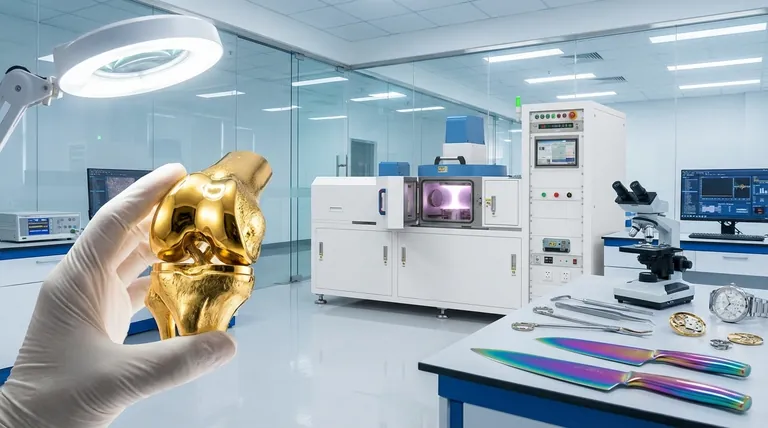In almost all common applications, PVD coating is not toxic. Physical Vapor Deposition (PVD) coatings are widely considered safe and are used extensively on food-grade products like cutlery, kitchen equipment, and medical implants. This safety stems from the use of chemically inert, biocompatible materials and an application process that creates an incredibly strong bond with the underlying material, preventing it from chipping or leaching.
The safety of PVD coatings is not just about the materials used, but the fundamental nature of the process itself. It creates a new, atomically-bonded surface condition rather than a simple layer of paint, ensuring extreme durability and chemical stability.

What Makes PVD Coatings Fundamentally Safe?
To understand why PVD is trusted in sensitive applications, it's essential to look at both the materials involved and the unique application process.
The Use of Inert Materials
Most PVD coatings intended for consumer products use materials that are biologically and chemically inert. Compounds like titanium nitride and zirconium nitride are common choices.
These materials do not react with the human body, food, or water. This inherent stability is a primary reason they are approved for use in both medical devices and food-contact items.
A Process of Atomic Bonding
PVD is not like painting or electroplating, where a distinct layer is applied on top of a surface. Instead, the process uses a high-vacuum chamber to vaporize a solid material into a plasma of atoms or molecules.
These particles are then deposited onto the target object, creating a bond at the micron level. As one of the references aptly states, this creates a new "surface condition" that is fused with the original material, not just sitting on top of it.
Exceptional Durability and Adhesion
The atomic bond created during the PVD process results in a finish that is incredibly hard and durable. It is far more resistant to wear, scratches, and chipping than traditional coatings.
This durability is directly linked to its safety. A coating that does not degrade or flake off under normal use cannot be accidentally ingested or absorbed.
Understanding the Trade-offs and Considerations
While the PVD process is inherently robust, its overall safety in a final product depends on the context of its application and manufacturing quality.
The Substrate Material is Critical
PVD coating improves the surface properties of a material, but it does not change the composition of the base material itself.
If a PVD coating is applied to a low-quality or toxic substrate (like a metal alloy containing lead), the product itself is not safe, even if the coating is perfectly applied. The integrity of the underlying object remains a crucial factor.
Application Quality Matters
The effectiveness and safety of a PVD coating hinge on proper application by a reputable manufacturer.
An improperly controlled process could result in poor adhesion, although this is rare in commercial-grade products. Always source PVD-coated items, especially for food or skin contact, from trusted brands with established quality control.
Not All Formulations Are Identical
While coatings for consumer goods are overwhelmingly safe, specialized PVD formulations exist for industrial applications (e.g., cutting tools) where biocompatibility is not the primary design goal. The safety of a coating is always tied to its intended use.
Making the Right Choice for Your Goal
When evaluating a PVD-coated product, your focus should align with its intended application.
- If your primary focus is kitchenware or cutlery: Look for products from reputable brands that explicitly state their coatings are food-grade, FDA-compliant, and designed for this purpose.
- If your primary focus is jewelry or watches: Prioritize coatings made from known biocompatible materials like titanium nitride, which are excellent for preventing skin irritation and discoloration.
- If your primary focus is tools or hardware: In this context, the inherent durability and corrosion resistance of the PVD process is the key benefit, ensuring a long-lasting and high-performance finish.
Ultimately, a properly manufactured PVD product provides a surface that is as safe and stable as it is durable.
Summary Table:
| Aspect | Why It's Safe |
|---|---|
| Materials Used | Biologically inert compounds (e.g., Titanium Nitride) that do not react with skin or food. |
| Bonding Process | Atomic-level fusion creates a durable, chip-resistant surface, not a simple layer. |
| Common Applications | FDA-compliant for cutlery, medical implants, jewelry, and high-performance tools. |
Need a reliable, non-toxic coating for your lab equipment or consumables? KINTEK specializes in high-performance PVD solutions that ensure durability and safety for sensitive laboratory environments. Contact our experts today to enhance your product's surface properties with our trusted coating technology!
Visual Guide

Related Products
- RF PECVD System Radio Frequency Plasma-Enhanced Chemical Vapor Deposition RF PECVD
- Chemical Vapor Deposition CVD Equipment System Chamber Slide PECVD Tube Furnace with Liquid Gasifier PECVD Machine
- Electron Beam Evaporation Coating Oxygen-Free Copper Crucible and Evaporation Boat
- VHP Sterilization Equipment Hydrogen Peroxide H2O2 Space Sterilizer
- Molybdenum Tungsten Tantalum Special Shape Evaporation Boat
People Also Ask
- What is plasma activated chemical vapour deposition method? A Low-Temperature Solution for Advanced Coatings
- Why is PECVD environment friendly? Understanding the Eco-Friendly Benefits of Plasma-Enhanced Coating
- What is an example of PECVD? RF-PECVD for High-Quality Thin Film Deposition
- How does RF power create plasma? Achieve Stable, High-Density Plasma for Your Applications
- How are PECVD and CVD different? A Guide to Choosing the Right Thin-Film Deposition Process



















